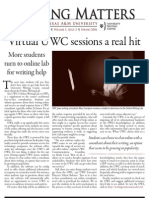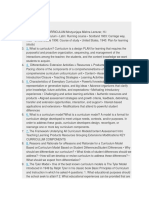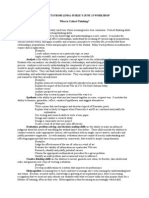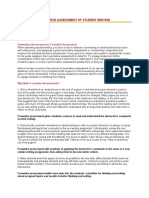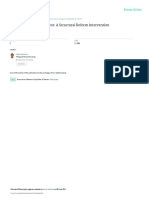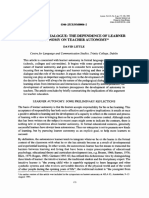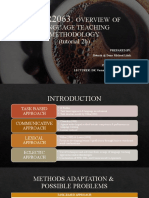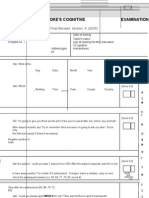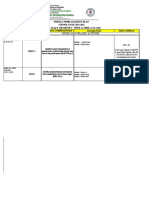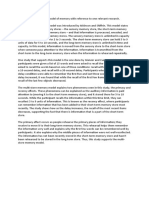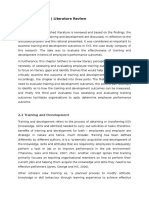Thesis
Thesis
Uploaded by
Jmex SherdicCopyright:
Available Formats
Thesis
Thesis
Uploaded by
Jmex SherdicCopyright
Available Formats
Share this document
Did you find this document useful?
Is this content inappropriate?
Copyright:
Available Formats
Thesis
Thesis
Uploaded by
Jmex SherdicCopyright:
Available Formats
CHAPTER I INTRODUCTION
A. Background of the Study Unavoidable, teaching is still a work hard. One ought to make an effort to understand, to repeat accurately, to manipulate newly understood language, and to use the whole range of knowledge at every moment must be maintained over a long period (Andrew, as cited in Wulandari, 2006). Based on this statement, a teacher should apply many kinds of techniques or methods in teaching learning process in order to get satisfactory result in teaching learning process. Therefore, the teacher should choose or find a good technique, approach or method to be presented in teaching learning process because a teacher has role in classroom activity. First, the teacher as instructor. In this case, teacher is the main information sources and teacher ought to master the material, teaching method and how to evaluate the students. The second one is teacher functions as an educator. In this case, the teacher leads the students attitude, mentality and good characteristic. And the third is a teacher as a manager. It relates to teachers question in classroom interaction and in this case, a teacher is one of learning resource in the classroom. A good teacher should be creative and innovative in teaching and learning process. Teacher hopefully understands about classroom situations, conditions and the students differences to help him or her to get the learning goals. It aims at attracting the students motivation in teaching learning process, and one of them is using teachers question.
Teachers question is identified as a critical part of teachers work. The act of asking a good question is cognitively demanding, it requires considerable pedagogical content knowledge and it necessitates that teachers know their learners well. A number of research studies have shown that teachers rarely ask higher order questions, even though these are identified as important tools in developing students understanding. The art of asking questions is one of the basic skills of good teaching. The question can be used by teacher to get students attention in teaching and learning process (User, 2006: 61). Whereas, Socrates (in http://Ezine Articles.com) believed that knowledge and awareness are an intrinsic part of each learner. Thus, in exercising the craft of good teaching an educator ought to reach into the learner's hidden levels of knowing and awareness in order to help the learner reach new levels of thinking. Through the art of thoughtful questioning teachers can extract not only factual information, but also aid learners in connecting concepts, making inferences, increasing awareness, encouraging creative and imaginative thought, aiding critical thinking processes, and generally helping learners explore deeper levels of knowing, thinking, and understanding. According to User (1995: 74), in teaching and learning process, questioning plays important roles and also can give positive effect to students. This statement was strengthened by Wus and Antonios statements. Wu (in Jasmawati, 2010: 1) stated that questioning is important method of teaching. The teacher is a professional question maker and suggests that question asking is one of he basic ways by which the teacher stimulate student thinking and learning in the classroom interaction, the questions have tended to be examined as a mean of eliciting more or less linguistics output
and
involving
students
in
interaction.
Meanwhile,
Antonio
(in
http://www.irene@CoachingForChange.com) stated that question technique is a good method to raise attention and make students ready to accept what the teacher said. Based on the above phenomenon, the researcher intends to investigate a study entitled Characteristic of English Teachers Question at the Fourth Graders Students of SDN 5 Korleko in the school year 2011/2012.
B. Focus of the Study In order to investigate more deeply, the subjects of the study were limited to the Fourth Graders Students of SDN 5 Korleko in the school year 2011/2012 while the object of the study was limited to the Characteristic of English Teachers Question.
C. Statement of the Problem Based on the explanation of the study above, the present researcher formulated the statement of the problems as follow: How is the characteristic of English teachers question at the fourth graders students of SDN 5 Korleko in the school year 2011/2012?
D. Purpose of the Study Based on the statement of the problems above, the purposes of this study were: 1. To know the Characteristic of English Teachers Question at the Fourth Graders Students of SDN 5 Korleko in the school year 2011/2012.
2.
To describe the Characteristic of English Teachers Question at the Fourth Graders Students of SDN 5 Korleko in the school year 2011/2012.
E. Significances of the Study This study was expected to have significance, both theoretically and practically. 1. Theoretical Significance a. The result of this study is expected to be able to add some concepts of knowledge in order to increase teachers competence, especially in making good questions. b. This research is expected to inspire the other researcher to conduct another research studies with similar problem. 2. Practical Significance a. The finding of this research may be useful as an input for the teacher in order to lead the .students in teaching and learning process. b. The teacher is expected to be able to increase the quality of question because it will give positive effect to the students.
CHAPTER II REVIEW OF RELATED LITERATURE
A. Characteristic of an Effective Teacher According to Alex (in http:/ www.personalitybook.com) he stated the definitions of effective teacher as below: 1. Love What He/She Does In this case, a teacher should love to teach. Not doing it for the money, prestige, or glory, he/she teaches because it brings him/her an incredible feeling of satisfaction knowing he/she is contributing positively to the futures of others. If a teacher does not have this inner satisfaction, and does not enjoy what he/she does, he/she will never be able to make lasting impressions in his/her students minds. Passion has great impact, and this is something that great teacher has. 2. Good Communicator A teacher has the responsibility of bridging the gap between himself/herself and his/her students. So, good communication skill is a must or an obligation that should be owned as a teacher. It is difficult sometimes too relate to people, especially children, so that learning can happen in their minds, but excellent teacher should master of this. Relating to students on the students level, a teacher has to develop many ways to reach his/her students, and communicate using terrific speaking skills, visual aids, and even in their body language. 3. Admirable In order for a teacher to be great, they ought to be admirable. A teacher
leads of high moral ground, and he/she sets an example to his/her students because of it. Really though, admirable teacher is more credible than others. Because of the great teachers guides them the way how to be good person and has good moral. 4. Positive Reinforcement Instead of using strict punishment to discipline students, the great teacher knows how to use positive reinforcement to discipline instead. A teacher understands that negatively hinders how his/her students learn, creates resentment in the students mind, and ends up breaking the ties of the students and teacher relationship by giving the students a reward for doing a good job, so they keep doing it in the future. 5. Fair Equality is an ideal that a teacher holds dear to himself/herself. He/she treats his/her students equally, does not give the individual attention for a student among them. No students are left out in the mind of a wonderful teacher, and he/she makes it a mission to teach them all the same. So, he/she ends up teaching his/her students the importance of equality and fair treatment, even if the teacher had not intended to do so. 6. Leadership It means, a teacher is a leader in the classroom, he/she owns the spotlight, and has the responsibility of being strong instructors so that students listen to him/her with determination. He/she has to lead their students on the right path through the learning experience, and helps by showing the obstacles that may stand in the students way. 7. Committed
There is no doubt that a teacher is committed. It means, he/she needs time requirements of a typical teacher and has a willing to help students whenever they need it. A teacher is very committed to the curriculum he/she teaches and likes his/her students are always continuing to learn in the hopes of becoming even better teacher. 8. Understanding In this case, a teacher should understand his/her students better than most people. He/she understands where their students came from, who they are, and knows the best avenue to take them are going to be. A teacher has an uncanny understanding of what he/she teaches, because he/she is experts in their fields of knowledge. 10. Confidence A teacher can not teach without confidence. Because, students do not believe a teacher has no confidence at all. So, confidence is the key and has important role to teach and related to the confidence, a teacher should do the best, not be arrogant about the job he/she does. In this case, a teacher should do it based on the norms/rules as a good teacher. 11. Prepared Excellent teacher is prepared. He/she knows the steps necessary in his/her curriculum to teach students, and follows them well. A teacher is always ready to go when the time calls for it and he/she never leaves his/her students lost and not knowing the direction he/she is faced. A teacher sticks to the plans he/she has prepared, in order in teaching process will be run as well as possible. 12. Professionalism
Professionalism is the sign of a teacher. He/she knows that as someone who is responsible for helping people learn, he/she ought to take his/her work seriously. Terrific teacher is a dress well, has good hygiene, and treats his/her students with respect. He/she believes in timeliness, and he is never late and rarely misses days he/she is assigned to work and it makes his/her students respect him/her. 1. Teaching and Learning Process Teaching and learning process is an approach of teaching and learning that connecting the material and classroom activities to the real situation and actual experience focusing on the learning process leading to creativity, critical thinking, problem solving, and being able to apply student knowledge in their daily lives (Departemen Pendidikan Nasional, 2003, p.11). Teaching and learning process is a dialogue between student and teacher in the classroom. Teaching and learning process is what goes on in the language classroom between the teacher and students to get the target language. It depends on curriculum design, and evaluation. 2. Teachers Classroom Interaction Tsui (1995, p.25) stated classroom interaction refers to the interaction between the teacher and learners and among the learners in the classroom. Teacher and student change some information like beliefs, social and culture background of the teacher and learner and complexities of classroom interaction. Classroom interaction focused initially on the language used by teacher, especially teacher questions and the learner response elicited, teachers feedback and turn allocation behavior. These features are
examined in light of how they affected interaction and the opportunities for learner to engage in language production. Long (as cited in Jasmawati, 2010) noted that classroom interaction is verbal communication between teacher and student. It two way exchange of information about material that goes in the classroom. Classroom interaction consists of three main aspects: input, interaction and output. a. Teacher Activity Teacher activity is all way of teacher in presenting the material in the classroom. Teachers spend their time in the classroom for explaining, controlling, modeling, solving problem, asking question, and giving feedback. Teachers need to know about their students prior knowledge, as it will be the based to learn new information. It needs to be activated before the teachers deliver the new information/knowledge. In teaching and learning activity, it is important for teachers to give model as an example that can be imitated by their students, for instance how to ask question well. By asking question, teachers can raise the students curiosities and motivation in asking various questions. Questions are important for a teacher because: 1. Questions tell a teacher that his/her students can understand and they are able to think about what the teacher says. If the teacher begins to talk at too high a level, students will stop understanding and starts thinking, and will ask no questions. Questions tell teacher whether his/her class is asleep or awake. 2. If students are curious, the students will ask questions about concepts they do not understand yet. These questions give a teacher immediate
feedback when a teacher teaches unclear, and tell a teacher where the students need to spend more time. b. Student Activity Student activity plays a significant role in shaping the pattern of classroom interaction. Student in general has a habit of waiting to be called upon before answering. Students are called upon to respond, they may prefer to hesitate and give short answers where possible so that they do not give their peers the impression that they are showing off. The student need chances to do reflection to express their learning outcomes both writing and orally. In orally student ask some question related to the material that presented. Questions are important to the students in a class for two reasons; (1) Students can learn how to ask questions well by asking some questions. From the question, they can receive the feedback and knowledge about how to present good questions. (2) A student asks a question is the moment for him/her to know what they do not understand yet and it indicates it is good to develop this behavior and ought to be nurtured.
B. Teachers Questions Teachers questions are made by a teacher to create teaching and learning process that will be effective and please. Because of in each learning stage, a teacher is prosecuted to submit question. Asking questions is an important and often overlooked skill. It can elevate of thinking and performance of students. Because question is used as a functional or speech act label and refers to an utterance
10
that seeks information. A question is characteristically express in the interrogative form. 1. Types of Question Wu (1993, p.91) said that question is characteristically expressed in the interrogative form. The term of question is used as a speech act label, and refers to an utterance that seeks information. It is now generally agreed that questioning is an important method of teaching. Ascher (as cited in Jasmawati, 2010) called: The teacher a professional question maker and suggest that question asking is one of basis ways by which the teacher stimulates student thinking and learning. In the classroom, question has tended to be examined as a means of eliciting more or less linguistic output and involving student in interaction. And according to Ascher (as cited in Jasmawati, 2010), there are some kinds of question that usually use by the teacher, they are: a. Referential Question Long and Satos (as cited in Jasmawati, 2010) pointed out that a question to which the teacher does not already know the answer. Example: have you finished? Nunan and Lamb (in
http://www.irene@CoachingFor Change.com) define question as those to which the asker does not know the answer. Ellis (1997, p.76) also explained that these are question which are genuinely information seeking. Lynch (in http://Education.Stateunivercity.com) argues that teachers should ask referential questions because learners tend to give long answer and learners will be less willing to answer question if their purpose is always to test knowledge.
11
b. Display Question Still Long and Satos argue that this question is a question to which the teacher already knows the answer. In asking a display question, the teacher does not seek an answer to resolve some doubts. e.g. what we call this kind of person. Meanwhile, Ellis (1997, p.125) defined the display question as one designed to test whether the addressee has knowledge of a particular fact or can use a particular linguistic item correctly. Lightbown and Spada (as cited in Jasmawati, 2010) noted that teacher ask display question not because they are interest in the answer but because they want to get their learners to display their knowledge of the language. c. Closed Question This question is which expect a small number of possible responses at its acceptable answers. e.g. can every body see that? Its answerable by yes or no. The closed question is one acceptable answer in mind (Ellis 1997, p.126). d. Open Question This a question to which a number of different answers would be acceptable. E.g. why do you think four is very good number? Nunan and Lamb (in http: //www.irene@CoachingForChange.com) describe open question as those that encourage extended student response. Meanwhile, Ellis (1997, p.127) suggested that in open question the teacher does not have a particular answer in mind and different response are possible. Meanwhile, Blosser (1975, p.33) stated that there are some series of questions that teacher can use to analyze their
12
question strategies and develop a variety of question to help student think. It will explain below. 1. Probing Question It series of questions which is require students to go beyond the first response. Subsequent teacher questions are formed on the basis of the students response. Types: a. Clarifying is question which require repeat the question. Examples: 1. What, exactly do you mean? 2. Will you please rephrase your statement? b. Increasing Critical Awareness Is Question Which Is Require an Idea Examples: 1. What are you assuming? 2. What are you reasons for thinking that it so? c. Refocusing is question which asks further information. Examples: 1. If this is true, what are the implications for? 2. Lets analyze that answer. 2. Factual Question Question which require the student to recall specific information she/he has previously learned. Often these use who, what, when, where, etc. Examples: 1. Who was the leader of the free French forces during W.W.II? 2. What are the steps a bill goes through before it becomes a law? 3. Divergent Questions
13
Question with no right or wrong answers, but with encourage exploration of possibility. Require both concrete and abstract thinking to arrive at an appropriate response. Example: what might happen if congress passes a law preventing the manufacture and sale of cigarettes in the United States? 4. Higher Order Question Question which is require students to figure out answers rather than remember them. Requires generalizations related to facts in meaningful patterns. Example: which of the two books do you believe contributed most to an understanding of the Victorian era? Why? 5. Affective Question Question which is elicit expression of attitude, values, or feelings of the student. Example: How do you feel about that? 6. Structuring Question Question related to the setting in which learning is occurring. Examples: Are there any questions? Any further comment? 2. Function of Question Questioning is a method of present the material in classroom interaction. Some function of question will be explained below. Aqib (2002, p.20) argues that questioning do by teacher to know how students understand about the material that presented. Further, Aqib (2002, p.21) stated by question, teachers can develop student question and
14
communication skill. Brown (1991, p.77) listed several functions of question, such as to arouse interest and curiosity concerning a topic, to focus attention on a particular issues or concept, to develop an active approach to learning, to stimulate pupils to ask questions to themselves and others. Nunan and Lamb (in http: //www.irene@CoachingForChange.com) state that teachers ask questions mainly to check learner understands, to elicit information and control their classroom. Peacock (as cited in Jasmawati, 2010) said that more often than not teachers appear to ask question either to find out what pupils do or do not know and understand, or to remind them about work completed in a previous lesson, or perhaps to challenge, stimulate and develop their thinking. Morgan and Saxon (as cited in Jasmawati, 2010) added that teacher ask question for several reasons. They ask question to keep their learners involved during lesson, to express their ideas and thoughts, to enable learners to hear different explanation of the material, and to help teacher to evaluate their learners learning and revise their lesson when necessary. Based on some experts ideas above, it is clear how important the teacher question in the classroom interaction. 3. Wait Time in Question Wait-time refers to the length of the pause which follows a teachers question to an individual student or the whole class. This last until either a student answers or the teacher adds a comment of poses another question. It can also apply to the period between one students answer to a question and response of the teacher of another student. A number of investigation in general education have found that wait-time can be altered by teachers but
15
tend be short, around one second. When wait-time is increased to three to five seconds, there is improvement in learning and in the quality of classroom discourse. Based on long et al, (as cited in Jasmawati, 2010), the principal study of wait-time found that increased wait-time after teacher question resulted in longer L2 student utterances. When teacher asking harder question, others tended to wait longer, but the difficulty such question is not always compensated by proportionately longer wait-time. Teacher might to try effects of simply waiting longer as they interaction with their SL students. Students in general have a habit of waiting to be called upon before answering. After called upon the response, they may prefer to hesitate and give short answers are possible so that they do not give their peers the impression that they are showing off. 4. The Purpose of the Questions The art of asking questions is one of the basic skills of good teaching. Socrates (in http://Education.Stateunivercity.com) believed that knowledge and awareness are an intrinsic part of each learner. Thus, in exercising the craft of good teaching an educator must reach into the learner's hidden levels of knowing and awareness in order to help the learner reach new levels of thinking. Through the art of thoughtful questioning teachers can extract not only factual information, but aid learners in: connecting concepts, making inferences, increasing awareness, encouraging creative and imaginative thought, aiding critical thinking processes, and generally helping learners explore deeper levels of knowing, thinking, and understanding. Teacher ask question for several reasons (in www.nationalgeographic.com/ resources/ngo/education/Chesapeake/html):
16
1. The act of asking questions helps teachers keep students actively involved in lessons 2. While answering questions, students have the opportunity to openly express their ideas and thoughts 3. Questioning students enables other students to hear different explanations of the material by their peers 4. Asking questions helps teachers to pace their lessons and moderate student behavior 5. Questioning students helps teachers to evaluate student learning and revise their lessons as necessary As one may deduce, questioning is one of the most popular modes of teaching. For thousands of years, teachers have known that it is possible to transfer factual knowledge and conceptual understanding through the process of asking questions. Unfortunately, although the act of asking questions has the potential to greatly facilitate the learning process; it also has the capacity to turn a child off to learning if done incorrectly. The purpose of this digest is to provide teachers with information on what types of question and questioning behaviors can facilitate the learning process as well as what types of questions are ineffective. 5. Effective Questions Asking question is an important and often overlooked skill. The ability to apply effective questioning techniques can elevate the thinking and performance of students, which in turn improve student performance and success as learning professional.
17
Borich (1992, p.346) stated that effective questioning is a function of two key factors: 1. The teachers having goal clearly and precisely in mind for lesson. 2. The teachers who question effectively are flexible and responsive to their student. Question need to be adjusted to the need of the students and requirement. In order to teach well, it is widely believed that one must be able to question well. Asking effective questions fosters interaction between the teacher and their students. Rosenshine (as cited in Brown, 1991) found that large amounts of student-teacher interaction promote student achievement. Thus, one can surmise that effective questions fosters student understanding. However, it is important to know that not all questions achieve this. Wilen and Clegg (in http://Education.Stateunivercity.com) suggest teachers employ the following research supported practices to foster higher student achievement: 1. Phrase questions clearly 2. Ask questions of primarily an academic nature 3. Allow three to five seconds of wait time after asking a question before requesting a student's response, particularly when high-cognitive level questions are asked 4. Encourage students to respond in some way to each question asked 5. Balance responses from volunteering and non volunteering students 6. Elicit a high percentage of correct responses from students and assist with incorrect responses
18
7. Probe students' responses to have them clarify ideas, support a point of view, or extend their thinking 8. Acknowledge correct responses from students and use praise specifically and discriminately.
C. Relevant Study This study is relevant to the study that was done by Jasmawati (2010) entitiled An Analysis on Teacher Question in Classroom Interaction at SMPN 1 Moyo Hulu in the school year 2010/ 2011. The problems of her study were; (1) what are the types of Teacher Question used by Teachers in the Classroom Instruction English Lesson? And (2) what are the functions of Teacher Question used by the Teacher in the Classroom Instruction English Lesson? The research design used in her study was descriptive qualitative and the subject was the Teacher of SMPN 1 Moyo Hulu in the school year 2010/2011. The instrument used to collect data of her study was observation, interview, tape recording technique and note taking. Based on the result of her study, she found that the English Teacher used some types of question such as referential question, display question and open and closed question. Then, the teacher used some functions of question in the classroom interaction in teaching and learning process like checking or testing the learner knowledge, practice part of language, get learner thinking and asking for clarification, eliciting personal idea and encouraging learners participation. The similarity of this study can be seen on: investigation variable: Jasmawati and the present researcher used the same variable that is teachers question. Research design; Jasmawati and the present researcher used the same
19
research design that was descriptive qualitative, and technique of data collection of the research; Jasmawati and the present researcher used the same technique of data collection they were observation and interview. Besides the similarity, this research has differences. It can be seen on the level of the investigation. Jasmawati investigated her research at Senior High Shool level meanwhile the present researcher investigated his research at Elementary school level.
D. Theoretical Framework The knowledge that is gained by someone is always started from questioning. One thing that should be taken into consideration is that the questioning activity of the teachers. Therefore, a teacher should have good questioning techniques, because a good question will raise the students curiosities, motivation, interest, and it can attract their attention to the thing they analyze or observe. In productive teaching and learning activity, questioning is useful to acquire information, check the students understanding, raise the students responses, know the students curiosity, know the students prior knowledge, focus the students attention and something, arise the students questions and refresh the students memory (Depdiknas, 2003, p.13). This study is not only a theoretical application but also practical application as well. Practical constituted the result of the study which is intended to be one consideration for the English teacher to create a good question strategy to make and improve the student ability, so they can receive the target of language.
20
CHAPTER III RESEARCH METHODOLOGY
A. Setting of the Study This study was done at 20 July until 20 August 2011 in the first semester at the fourth graders of SDN 5 Korleko in the school year 2011/2012.
B. Research Design This study was qualitative descriptive research, because it was designed to collect, describe, and analyze characteristic of English teachers questions. The data which was collected, described, and analyzed related to the types and functions of teachers question in teaching and learning process.
C. Subject of the Study In this part, the present researcher explained about: 1. Population of the Study Gay (1992, p.125) argued that population is the group of interest to the present researcher, the group to which she or he is like the results of the study had generalized. Based on this definition above, it could be said that population was the whole subjects that had been investigated. The target population of this study was all of the fourth graders of SDN 5 Korleko in the school year 2011/2012. 2. Sample of the Study According to Gay (1992, p.125), sample was a number of individuals for a study in such a way that the individuals represent the larger group from
21
which they are selected. Reffering to this definition, the present reseacher took one class from the total of population by using purposive sampling. As the result, the class IV was chosen as the sample of the study which consisted of 24 students.
D. Collecting Data 1. Instruments of the Study In a qualitative study, present researcher plays an important role as the key instrument. Thus, the researcher himself is the key instrument of the present study that applied some resource of data collection such as a writing pad, a tape-recorder, and a pen that will be brought to the site. First, a taperecorder was the main equipment was used in this study to obtain primary data in relation to the types and function of teachers question employed by the teacher in SDN 5 Korleko. Second, a writing pad and pen was used to gather interview as secondary data regarding a situation or event that occurs along with the use of teachers question in SDN 5 Korleko in the school year 2011/2012. 2. Technique of Collecting Data Related to technique of collecting data, the data from this study was taken from various sources, mainly through observations and interviews. Data collection was taken through the techniques of tape-recording and note taking. In addition, the researcher also used some resources such as a writing pad and pen. a. Observation The observation was applied in this study was classroom observation,
22
which particularly was taken the types of a non participant observation. Such a type of observation is intended to maintain the natural context of classroom situation, where the subject was not disturbed by the presence of the researcher during English classes. Non participant observation, as data collection method, was applied to get supported data related to characteristic of teachers question during the classroom interaction. The observation was administered five times. In each session of observation, the researcher was recorded the subject utterances in the course of teaching learning process. The data was collected through a tape recording data for the analysis of the research questions. In edition, the researcher as well took the same notes on the situation or events that underline the application of teachers question in the classroom interaction. The data was collected through a note-taking to support the analysis of the research question. b. Interview Part of data was gathered through interview. In the present researcher, the researchers was applied an open interview. It is called an open interview in the sense that the researcher allowed the subjects to talk and gave detail accounts toward the use of teachers question in the classroom interaction. The data collecting through interviews was used for the analysis of the research question. In the interview sessions, the researcher conducted both a tape-recording activity and note-taking activity. E. Analyzing Data In this part, the present researcher analyzed the data by using four procedures in the following steps as follow: 1. Data Reduction
23
The data was obtained from the observation, interview, and note taking which was reduced through five steps Miles and Huberman (as cited in Sugiono, 2007), they were: a. Selecting In this step, the researcher preceded all data from observation and interview. b. Simplifying In this second step, the researcher was simplify all data were relevant to the study. c. Classifying In the third step, the researcher selected the data. Then, those data was put into the extraction sheets. In the extraction sheets, all the relevant data was arranged according to five sessions of collecting data. d. Categorizing In this step, the researcher categorized and analyzed of the data selected based on the basis theory that was adopted in this study. e. Coding data In the last steps, the researcher selected the data were coded according to the serial number and the entry number of the data on the transcription sheets. 2. Data Description The data which were reduced was described as a research data and it contains types and function of the teacher question symptom. This data was analyzed by using qualitative descriptive to look for the kinds and the functions of teacher question available in the data of the research.
24
3. Data Display In relation to data display, there are two matrixes that were presented the data as the results of the reduction process. There were a matrix of types of teacher question which is shown in table 1 and a matrix of function of teacher question which was shown in table 2. In term of data display, the researcher used such codes as R stand for recording, numeration 1 to 9 referred to the sessions of recording from the observation in the classroom interaction. Table 1 showed the data display of types of teacher question used by the subject as follow. Table 1. Types of Teacher Question Employed by the Participant. No Type of Teacher Question 1 2 3 4 Referential Question Display Question Open Question Closed Question R1 R2 R3 R4 R5 R6 R7 R8 R9
Table 2 showed the data display of function of teacher question as follows. Table 2. Function of Teacher Question in Classroom Interaction No Function of teacher question 1 Practice part of language R 1 R 2 R 3 R 4 R 5 R 6 R 7 R 8 R 9
25
2 3 4 5 6 7
Elicit personal ideas Asking for clarification Encourage learner participation Shows interest Check or test learner knowledge Get learner think
4. Conclusion Drawing This is the activity of research conclusion based on the research that focus to answer the problems which has been formulated in chapter I. the research conclusion can be tested its trustworthiness by reexamining the field data got. The temporary conclusion was taken based on data reduction and data description. Inductively, the present researcher attracted a temporary conclusion as the result of research according to the types and function of teachers question in classroom interaction which was seen in utterances applied by the teacher as language data. The temporary conclusion can be tested its tendency after data was grouped and analyzed by data from the result of observation, interview, and note-taking. So, this examination was confirmed the temporary conclusion.
26
CHAPTER IV RESEARCH FINDING AND DISCUSSION
This research deals with research finding and discussion. The research finding begins with school profile, teacher profile, and teacher perception and experiences especially in the classroom interaction. The last section presents the discussion and the overall data. A. School Profile Elementary school 5 Korleko is one of SDN in Korleko where the teachers come from different area and many background, but almost all the teachers in this school were S-1 degree. It consist of 10 teachers, one Head master and one administrator. The school building consist of 6 classes, a teachers room, a administration room, a head masters room and a small library. B. Teachers Profile Name Date and Place of born Gender University Year of Graduate Religion Status Experience : Hairul Hafizin S.Pd : Korleko, 14 Juni 1985 : Male : STKIP HAMZANWADI Selong : 2009 : Islam : Non PNS : MGMP and Some Seminars
C. Teacher Perception and Experience
27
This research consisted of one teacher, where the researcher took an English teacher as participant. Based on my my classroom observation and talked with the teacher, the object in this research were two categories. One category was types of question and the other one was the function of teacher question. The teacher delivers some qurstion in difference type and function, then the students responded to the teacher questions, some time they also asked question. Based on my observation the classroom interaction used Indonesian language or vernacular mostly. It was caused by the student by the student poor in english vocabulary so the teacher must combine the language in given explanation.Its the way to make the student about the material that presented. In general an english teacher usually tried to make the class alive and gave question more explicitly, so the students could understand. The researcher found the teacher delivered question in multi types different style. Usually the teacher asked question used english sentence, but the learners sometime couldnt catch the point. To face this case the teacher explained with the simplifier sentence, then if the learners were still confuse, the teacher made it clear by translating the word one by one into Indonesian. Finally, the learners understood and tried to answer the teacher question between the teacher and the learners was running well, especially in asking and answer the question.
D. Classroom Interaction Based on the research observation in the classroom, interaction occurred between the teacher and the learners, and among the learners. The teacher conducted the teaching and learning activity and presented the material.
28
The teacher gave explanation, controlled the class, solved problemn and asked question. Teacher in this case tend to led the learner to feel confident in expressing their idea by delivering question or answer the question.
E. Teacher Question The question technique is one of stimulate for the student to think and learn, so gthe student can master the material that presented easily. Teacher question is one methode to lead the student to communicate and active in teaching and learning process.
1. Types of Teacher Question Defending on the transcript of tape-recording that the researcher did, the types of teachers question occurred randomly. The specific of the types of teacher question were presented in the table 1, Table 4.1: Types of teacher question in classroom interaction No Type of Teacher Question 1 2 3 Referential Question Display Question Open Question R R 1
x x -
R 3
xx x -
R 4
x x -
R 5
x x -
R 6
x xx xx x
R 7
x -
R 8
x x
R9
Total
2
x xx x
x -
8 10 5
Closed Question
xx
29
The researcher used some codes in explaining the result of the research. The X symbol stand for the types of question appear in session of recording from the result of observation in the classroom interaction. One X means that the each type of question appears once in the interaction, and so on. The hyphen symbol stand for the types of question not appear in session of recording. a. Referential Question Referential question in the table above can be seen at R1-1, R2-1, R3-2, R4-1, R5-1, R6-1, and R8-1. Its type not occurs at R7 and R9. The characteristic of referential question is the teacher does not know the answer. E.g. T3 (11) Who has a cow? T3 (11) What is your name? Based on the example above, the teacher seeking information purely, and he got the answer My name is Awan. Before asking question, the teacher does not already know that student name, after deliver aquestion he known that the student name was Awan. b. Display Question The table shown display question mostly occur. Its types are in R11, R2-1, R3-1, R4-1, R5-1, R6-2, R7-1, and R9-1. This question was not said by the teacher in R8. Display question means the teacher asking question that he/she had already known the answer. E.g. T1 (1) What does mean of introduce? T3 (2) What is the function of mobile phone?
30
The teacher delivers the question that he already known the answer. When he asking the question, the the studend silent, so the teacher give answer of his question by saying to make communication, what else?. Its means, the teacher had known the answer basically, but he delivers the question just to elicit personal idea. c. Open Question. Open question was asking very rare. Its question expect the different answer. The table shows R2-1, R6-3, and R8-1. E.g. T2 (9) Why must we wait until the water is poured? T8 (8) Why are you aafraid? Common dont be shy. In the first question, the difference answer were occurs. One student gave the reason by saying so, it is not too hot, and the other one said to make the tea more delicious. In the second question the teacher ask how to make an advertisement example, the difference answer also occurs. One student answer Im not shy but I cant. it means, the teacher in asking the open question, would have difference answer because the question aimed to get the learner think, So it would not same answer accept by the differnce student. d. Closed Question The closed question requires only one answer like yes or no. this types was enough common said by the teacher in the teaching and learning process. It is shown in the table above R3-1, R4-1, R5-1, R6-2, and R8-1. R1, R2, and R7 do not indicate this type. T3 (2) Are you ready to study English?
31
T5 (14) Do you understand? Based on the example above, the question just requires one answer between yes or no. the first question aimed to show the student interest toward the English subject and the second one was check the student knowledge.
2. The Function of Teacher Question Based on the interview the participant shared some advantages of question. Those were describe bellow: 1. To arouse curiosity of the student toward the material that was presented. 2. To enhace the student participation in teaching and learning process. 3. To make student learning actively. 4. To lead the student to think about the material. 5. To focuses the students attention about the material. The function referential question, display question, open and closed question was categorized in the table below. Table 4.2 function of teacher question. No Function of teacher question 1 2 Practice part of language Elicit personal ideas
x x x xx x xx x
R 1
R 2
R 3
R 4
R 5
R 6
R 7
R 8
R 9
Total
8 2
32
Asking for clarification Encourage learner
x x
x x
6 2
4 participation 5 Shows interest Check or test learner 6 knowledge
x xx xx x x x x xx x xx x xx xx xx x x
17
Get learner think
F. Discussion
The display questions mostly occurred. Display question refer to those question for which the teacher knows the answer beforehand. The referential question was the second place that occurred. It was a teacher asks the referential question to seek information purely. The closed question was quite common said by the teachr in the clssroom interaction. It expects very limited answer yes or no and open questio was very rarely. This question expects different answer. The most common function of question was checking or testing learners knowledge and practice part of language in the second place. The third places of function in teacher question were get learner think and asking for clarification. Then, asking to elicit personal idea and encourage learner participation quite common appears in classroom interaction. The question showing interesting seldom occurred.
33
CHAPTER V CONCLUSSION AND SUGGESTION
A. Conclusion 1. Teacher question was very important way for the classroom
interaction. By asking question, teacher can analyze the student achievement of the material that presented. Asking question by the teacher can do when the class starts, in the middle even in the last of the teaching and learning process. 2. Some function of teacher question were practice part of language, elicit personal idea, asking for clarification, encourage learners
participation, show interest, check or test learner knowledge and get the learners think.
B. Suggestion 1. An English teacher must pay attention to the questioning technique, so they can make the classroom activity more alive and more communicative. 2. In teaching and learning process . an English teacher must try to ask question in the English firstly, and avoid use the vernacular. 3. An English teacher must use the right question to elicit the target language in the classroom interaction
34
You might also like
- Formative Assessment 1 Applied Ethics (Ged0114) InstructionDocument3 pagesFormative Assessment 1 Applied Ethics (Ged0114) InstructionMaryrose Sumulong100% (1)
- Writing Matters Writing Skills and Strategies For Students of EnglishDocument8 pagesWriting Matters Writing Skills and Strategies For Students of EnglishTamarNo ratings yet
- Models of CurriculumDocument7 pagesModels of CurriculumMark San AndresNo ratings yet
- Pree SchoolDocument12 pagesPree SchoolteodoraeneNo ratings yet
- Integrating Project-Based Learning in An English Language TourismDocument327 pagesIntegrating Project-Based Learning in An English Language TourismHo HaNo ratings yet
- 3 School Culture The Hidden Curriculum - 3Document8 pages3 School Culture The Hidden Curriculum - 3api-321107718No ratings yet
- Sarah Wengerter Master Research Proposal 2015Document20 pagesSarah Wengerter Master Research Proposal 2015api-315705429No ratings yet
- Article Formative-Assessment PDFDocument12 pagesArticle Formative-Assessment PDFChip D. Teach100% (1)
- Self-Study Project Intrinsic and Extrinsic MotivationDocument7 pagesSelf-Study Project Intrinsic and Extrinsic Motivationapi-247222888No ratings yet
- Materials DevelopmentDocument15 pagesMaterials DevelopmentlihpNo ratings yet
- Suskie HandoutsDocument15 pagesSuskie HandoutsAnnaNo ratings yet
- IRF ArticleDocument12 pagesIRF ArticleYashar NuriyevNo ratings yet
- ReadabilityDocument78 pagesReadabilityminibeanNo ratings yet
- 613 Course SyllabusDocument8 pages613 Course SyllabusStanley L. SwartzNo ratings yet
- Developing A ChecklistDocument16 pagesDeveloping A ChecklistHà VyNo ratings yet
- Stenhouse-1979-Research As A Basis For TeachingDocument24 pagesStenhouse-1979-Research As A Basis For TeachingNicolás Borgmann0% (1)
- Communicative Approach To Language TeachingDocument2 pagesCommunicative Approach To Language TeachingVera A. GuljašNo ratings yet
- Active Learning MethodDocument32 pagesActive Learning MethodPatimah Indri RaspatiNo ratings yet
- Biography of Hilda TabaDocument1 pageBiography of Hilda Tababonifacio gianga jr0% (1)
- Effects of an Inclusion Professional Development Model on Inclusion Knowledge and Perceptions of Regular Middle School EducatorsFrom EverandEffects of an Inclusion Professional Development Model on Inclusion Knowledge and Perceptions of Regular Middle School EducatorsNo ratings yet
- Research Template For G12 QNR PDFDocument4 pagesResearch Template For G12 QNR PDFJohn Paul Castillo VallenteNo ratings yet
- Current Trends in Teaching and Learning VocabularyDocument38 pagesCurrent Trends in Teaching and Learning VocabularyvinhekNo ratings yet
- The Learning Environment Is Supportive and ProductiveDocument8 pagesThe Learning Environment Is Supportive and Productiveasiano_24No ratings yet
- BlackandWiliam Ed 5nov03Document2 pagesBlackandWiliam Ed 5nov03monicapamerNo ratings yet
- Emerging Trends in English Language Teaching by DR Reena MittalDocument5 pagesEmerging Trends in English Language Teaching by DR Reena Mittalijr_journalNo ratings yet
- Formative Assessment of Student WritingDocument2 pagesFormative Assessment of Student WritingAdhitya FaniNo ratings yet
- Shohamy 2001 Testing PDFDocument19 pagesShohamy 2001 Testing PDFAnindita PalNo ratings yet
- Hum - Fostering Critical Thinking in Large Classes-Dr. Ekua Tekyiwa Amua-SekyiDocument14 pagesHum - Fostering Critical Thinking in Large Classes-Dr. Ekua Tekyiwa Amua-SekyiImpact JournalsNo ratings yet
- An Assessment of The Use of Elaboration Theory Strategies in Teaching Grammar: Basis For Developing A Monitoring ProgramDocument2 pagesAn Assessment of The Use of Elaboration Theory Strategies in Teaching Grammar: Basis For Developing A Monitoring ProgramIJAR JOURNALNo ratings yet
- AssesmentDocument2 pagesAssesmentHaki ElekNo ratings yet
- Assignment - Planning An Action ResearchDocument6 pagesAssignment - Planning An Action ResearchAsma Ali100% (2)
- WIPPEA Lesson PlanningDocument3 pagesWIPPEA Lesson PlanningHarry ChicaNo ratings yet
- Reflective Thinking Through Teacher Journal WritingDocument16 pagesReflective Thinking Through Teacher Journal WritingJo ZhongNo ratings yet
- Sla TheoryDocument34 pagesSla TheoryMorela Alfonzo ArrivillagaNo ratings yet
- Curriculum Framework Guidelines PDFDocument14 pagesCurriculum Framework Guidelines PDFRichard Nana Boakoh100% (1)
- The Relationship Between Student Engagement, Mith or RealityDocument10 pagesThe Relationship Between Student Engagement, Mith or RealityLuthfiana may sarahNo ratings yet
- Teaching: Prepared by PayalDocument10 pagesTeaching: Prepared by PayalKAJAL RANINo ratings yet
- School BasedManagementAStructuralReformInterventionbyArthurAbulencia PDFDocument31 pagesSchool BasedManagementAStructuralReformInterventionbyArthurAbulencia PDFRicoNo ratings yet
- Task-Based Learning: Based Learning, Jane Willis Presents A Three Stage ProcessDocument1 pageTask-Based Learning: Based Learning, Jane Willis Presents A Three Stage ProcessMãdãlina MitranNo ratings yet
- Classroom Management Practices and LearnDocument16 pagesClassroom Management Practices and LearnNapoleonNo ratings yet
- Approaches in Curriculum DesignDocument27 pagesApproaches in Curriculum DesignSaporna Laarni100% (1)
- Taxonomy of Educational Objectives Handbook 1 Cognitive DomainDocument31 pagesTaxonomy of Educational Objectives Handbook 1 Cognitive DomainAliNo ratings yet
- Fostering International Student Success in Higher Education, Second Edition: copublished by TESOL and NAFSAFrom EverandFostering International Student Success in Higher Education, Second Edition: copublished by TESOL and NAFSANo ratings yet
- Project Based Learning Essentials ChecklistDocument2 pagesProject Based Learning Essentials Checklistelowman26No ratings yet
- Handbook of Research on TeachingFrom EverandHandbook of Research on TeachingCourtney BellNo ratings yet
- Synthesis Reaction Paper 1Document4 pagesSynthesis Reaction Paper 1api-353957387100% (1)
- Formative Evaluation Plan: Expert ReviewDocument4 pagesFormative Evaluation Plan: Expert ReviewFarnoush DavisNo ratings yet
- Extensive Listening in CLT in EFL ContextDocument9 pagesExtensive Listening in CLT in EFL ContextAbir BotesNo ratings yet
- Assessment Tools in Assessing Students LearningDocument3 pagesAssessment Tools in Assessing Students LearningRENIEL RAGMA100% (1)
- Autonomy Benson2007Document20 pagesAutonomy Benson2007Darío Luis Banegas100% (2)
- Top 5 Teaching StrategiesDocument4 pagesTop 5 Teaching StrategiesRoy C. EstenzoNo ratings yet
- An Introduction To Action ResearchDocument6 pagesAn Introduction To Action ResearchEzra AnyalaNo ratings yet
- Birds' Eye View of ELL ProgrammingDocument4 pagesBirds' Eye View of ELL ProgrammingJohn WolfeNo ratings yet
- Knowles Antragogie PDFDocument4 pagesKnowles Antragogie PDFCorina Panfil100% (1)
- Language Learner Autonomy WhatWhyHow PDFDocument13 pagesLanguage Learner Autonomy WhatWhyHow PDFLilith DivineNo ratings yet
- Innovative TeachingDocument7 pagesInnovative Teachingkevin_aloeNo ratings yet
- Teaching Writing With Authentic Video in EFL ClassroomDocument11 pagesTeaching Writing With Authentic Video in EFL Classroomkafryawan wiraNo ratings yet
- Challeges Facing EFL Teachers in Mixed Ability ClassesDocument13 pagesChalleges Facing EFL Teachers in Mixed Ability ClassesAnonymous rWJCoarANo ratings yet
- David LittleDocument7 pagesDavid Littlenaila100% (1)
- Foreign Teachers TrainningDocument10 pagesForeign Teachers TrainningViviane Raposo PimentaNo ratings yet
- Lesson Plan For Reading and WritingDocument5 pagesLesson Plan For Reading and WritingJeffrey Paez San RamonNo ratings yet
- Slo Essay: Rhetorical KnowledgeDocument9 pagesSlo Essay: Rhetorical Knowledgeapi-511504911No ratings yet
- GRADES 1 To 12 Daily Lesson LogDocument3 pagesGRADES 1 To 12 Daily Lesson Logecardnyl25No ratings yet
- TSBR2063 TUTORIAL 2bDocument7 pagesTSBR2063 TUTORIAL 2bDebrah RocxNo ratings yet
- Factors of Not Wearing School Uniform in Relation To Academic PerformanceDocument12 pagesFactors of Not Wearing School Uniform in Relation To Academic PerformanceJohn Rey Logrosa100% (6)
- Career Development TheoriesDocument9 pagesCareer Development TheoriesRica Daniella P. BALUYUT100% (2)
- Holidays HomeworkDocument2 pagesHolidays HomeworkRajdeep SinghNo ratings yet
- Social and Emotional Influences On Human DevelopmentDocument223 pagesSocial and Emotional Influences On Human DevelopmentRojas CNo ratings yet
- 950 Maharati LMS Infographic ENDocument1 page950 Maharati LMS Infographic ENadityakaul17No ratings yet
- Addenbrooke's Cognitive Examination (ACE-R) (1) - NewDocument13 pagesAddenbrooke's Cognitive Examination (ACE-R) (1) - NewEcaterina ChiriacNo ratings yet
- Health Literacy Action PlanDocument72 pagesHealth Literacy Action PlanRaghavendra KamurthiNo ratings yet
- Concepts and Techniques: Data MiningDocument78 pagesConcepts and Techniques: Data MiningDiaa MustafaNo ratings yet
- Grade 8 Music and ArtsDocument16 pagesGrade 8 Music and ArtsKristela Mae ColomaNo ratings yet
- Least Masterd Competencies AutoRecoveredDocument4 pagesLeast Masterd Competencies AutoRecoveredCristyn BrusolaNo ratings yet
- SAQ - Multi Store Memory ModelDocument1 pageSAQ - Multi Store Memory ModelAnanyaNo ratings yet
- Gallery Walk Evidence For Competency 3cDocument17 pagesGallery Walk Evidence For Competency 3capi-428898897No ratings yet
- Leadership Style Self AssesmentDocument3 pagesLeadership Style Self AssesmentsaimanteeNo ratings yet
- Strategies To Develop School LeadershipDocument46 pagesStrategies To Develop School LeadershipVishnu SharmaNo ratings yet
- Ex Good Lesson PlanDocument3 pagesEx Good Lesson PlanDienha ViyelaNo ratings yet
- The Effects of Different Parenting Styles of Students' Academic Performance in Online Class SettingDocument29 pagesThe Effects of Different Parenting Styles of Students' Academic Performance in Online Class SettingSnowNo ratings yet
- Distracted Driver Detection Using Deep Learning AlgorithmsDocument37 pagesDistracted Driver Detection Using Deep Learning AlgorithmsSubhana HashmiNo ratings yet
- Using ChatGPT and Prompting Like Leonardo Da VinciDocument58 pagesUsing ChatGPT and Prompting Like Leonardo Da VinciKamal A. AL-HumaidiNo ratings yet
- Pssi 5Document3 pagesPssi 5fuckyouscribd2013041No ratings yet
- Diana Barnett Course Critique n5327 RDocument4 pagesDiana Barnett Course Critique n5327 Rapi-308950624No ratings yet
- Learning: General Psychology NotesDocument12 pagesLearning: General Psychology NotesKizhakkedom Krishnankutty ShijuNo ratings yet
- Chapter Two - Literature ReviewDocument32 pagesChapter Two - Literature ReviewsonyNo ratings yet
- Eapp q2 Module 7 Lecture Notes 7Document19 pagesEapp q2 Module 7 Lecture Notes 7Rica Anette MañozoNo ratings yet
- Annlouisecunliffe Must I Grow A Pair of Balls To Theorize About Theory in Organization and Management StudiesDocument28 pagesAnnlouisecunliffe Must I Grow A Pair of Balls To Theorize About Theory in Organization and Management Studiesprof.carolportoNo ratings yet
- Theoretical Foundations For Intelligent Tutoring Systems: John SelfDocument12 pagesTheoretical Foundations For Intelligent Tutoring Systems: John SelfNubli HawariNo ratings yet
- Q2-PPT-ARTS10-Week4 (The Use of Technology-Based Art To Derive Traditions and History)Document25 pagesQ2-PPT-ARTS10-Week4 (The Use of Technology-Based Art To Derive Traditions and History)Lemuel Español Camus100% (1)

